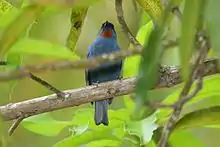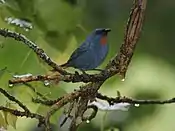Orangequit
The orangequit (Euneornis campestris) is a species of passerine bird in the tanager family Thraupidae and is the only member of the genus Euneornis. It is endemic to Jamaica where its natural habitats are subtropical or tropical moist lowland forests and heavily degraded former forest.
| Orangequit | |
|---|---|
 | |
| Male | |
| Scientific classification | |
| Kingdom: | Animalia |
| Phylum: | Chordata |
| Class: | Aves |
| Order: | Passeriformes |
| Family: | Thraupidae |
| Genus: | Euneornis Fitzinger, 1856 |
| Species: | E. campestris |
| Binomial name | |
| Euneornis campestris | |
| Synonyms | |
|
Motacilla campestris (protonym) | |
The Orangequit's breeding season is between the months of April and June. The species will build nests out of grass and plant fiber and place them in trees almost six meters above the ground. The female will typically lay 2-4 eggs at a time and will incubate. The appearances differs according to their sex and age.
Taxonomy
The orangequit was formally described by the Swedish naturalist Carl Linnaeus in 1758 in the tenth edition of his Systema Naturae under the binomial name Motacilla campestris.[2] Linnaeus based his description on the "American Hedge-Sparrow" that George Edwards had described and illustrated in his 1750 work, A Natural History of Uncommon Birds, from a specimen collected in Jamaica.[3] The species was moved to the genus Euneornis by the Austrian zoologist Leopold Fitzinger in 1856.[4] The genus name Euneornis combines the Ancient Greek eu meaning "good" with the genus Neornis introduced by Edward Blyth in 1845 and now a junior synonym of Cettia. The specific epithet campestris is Latin and means "of the fields".[5][6] The species is monotypic: no subspecies are recognised.[7]
 male
male male
male female
female female
female
References
- BirdLife International (2012). "Euneornis campestris". IUCN Red List of Threatened Species. 2012. Retrieved 26 November 2013.CS1 maint: ref=harv (link)
- Linnaeus, Carl (1758). Systema Naturae per regna tria naturae, secundum classes, ordines, genera, species, cum characteribus, differentiis, synonymis, locis (in Latin). Volume 1 (10th ed.). Holmiae (Stockholm): Laurentii Salvii. p. 184.
- Edwards, George (1750). A Natural History of Uncommon Birds. Part 3. London: Printed for the author at the College of Physicians. p. 122, Plate 122 fig. 2.
- Fitzinger, Leopold (1856). "Über das System und die Charakteristik der natürlichen Familien der Vögel". Sitzungsberichte der Kaiserlichen Akademie der Wissenschaften. Mathematisch-Naturwissenschaftliche Classe. 21: 277–318 [316].
- Mayr, Ernst; Cottrell, G. William, eds. (1986). Check-List of Birds of the World. Volume 11. Cambridge, Massachusetts: Museum of Comparative Zoology. p. 8.
- Jobling, James A. (2010). The Helm Dictionary of Scientific Bird Names. London: Christopher Helm. pp. 87, 268. ISBN 978-1-4081-2501-4.
- Gill, Frank; Donsker, David; Rasmussen, Pamela, eds. (July 2020). "Tanagers and allies". IOC World Bird List Version 10.2. International Ornithologists' Union. Retrieved 15 November 2020.
- Raffaele, Herbert; James Wiley, Orlando Garrido, Allan Keith & Janis Raffaele (2003) Birds of the West Indies, Christopher Helm, London.

